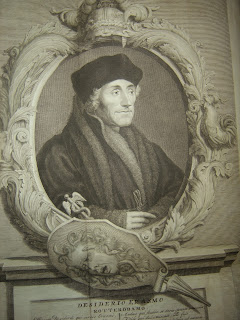 |
| John Calvin's Insitution of the Christian Religion in Spanish. Photograph by David Morrison by permission of the Dean and Chapter of Worcester (U.K.). |
The Cathedral library has a copy of the second edition of John Calvin’s book entitled Institution of the Christian religion, comprising of four parts, each divided into chapters. It was published in 1597 by Ricardo del Campo after being translated into Spanish or the “Castilian tongue” by Cypriano de Valera.
.jpg) |
| Woodcut of John Calvin, from . Reproduced by the permission of the Dean and Chapter of Worcester Cathedral (U.K.) |
He sets out his work as a lawyer might, illustrating his arguments with detailed references from the Old Testaments and the gospels, writing with fervour and convinced that his Protestant ideas on the Reform of the Christian church are the only valid ones; that he is a warrior of Christ combatting the corrupt practices of the Catholic Church with his teaching and preaching.
Calvin saw the Roman Catholic Church as in the power of
Satan, and took every opportunity to condemn its way of worshipping Christ. In his
Preface he mentioned the Diet of Augsburg, one of the conferences organized by
the Catholic Church to promote the Counter Reformation and heaped scorn on the
“lies” they published about him. His duty was, with God’s grace, “to so prepare
and instruct those who wish to study theology that they might easily learn Holy
Scripture, have a clear understanding of what they might read and walk a
straight path from which they never depart.” The end of the shorter preface
stresses that the book deals so fully and clearly with all matters of religion
that every reader who perseveres will be given a very useful tool with which to
live a godly life and refute the statements of “the Enemny”. Calvin wanted no
praise for his achievement but to be remembered before God by those who found
spiritual benefit in the pages of the book.
Like other reformers, Calvin was a product of ideas stemming
from the Renaissance. Scholars prized the Greek and Roman civilizations and in
their intensive study of Green and Latin discovered new ways of looking at the
language and meaning of the Bible in its original tongues, and the enigma of
human existence. Such men were called “humanists”. Unfortunately the different
ways they interpreted what they found set in motion religious divisions which
remain to this day.  |
| Erasmus from a Worcester Cathedral Library book. Photograph by David Morrison, by permission of the Dean and Chapter of Worcester Cathedral (U.K.) |
In Spain humanism began to take root in the very early sixteenth century, when Erasmus’ writings began to be read in Spain. Spanish universities began to study and discuss the new religious ideas. The Catholic Church, however, was quick to imprison even moderate thinkers like Luis de León whose statue stands facing the old university building of Salamanca today. By the time Erasmus died in 1536, the Inquisition had pounced upon any attempt at reform and religious humanism was sent underground, though in the plastic arts and in literature the study of Renaissance ideas brought about what is called in Spain “El Siglo de oro” (“The Golden Age”), which spanned two centuries and produced world class artists and authors, reflecting the influence and splendour of the Catholic Church.
Betty Eggby
No comments:
Post a Comment